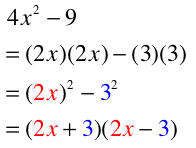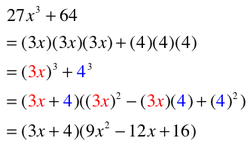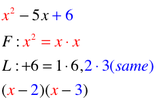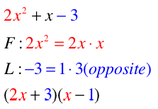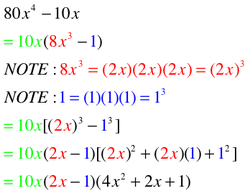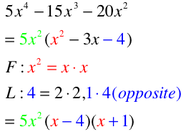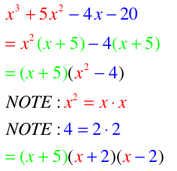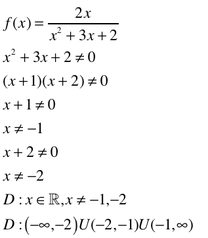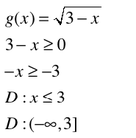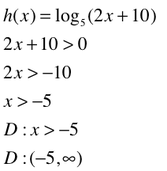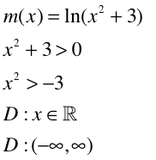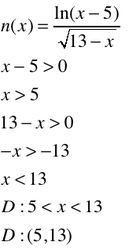OMG ,THIS PROBLEM IS EVERYWHERE:
Write the equation of a line given some info...
OPTION 1: Slope-Intercept Form (y= mx + b)
|
Example #1: Given the SLOPE and a POINT.
Give the equation of a line with a slope of 2 through the point (1, -5.)
OPTION 1 (Slope-Intercept Method) y = 2x + b -5 = 2(1) + b -5 = 2 + b -7 = b y = 2x - 7 done. OPTION 2 (Point-Slope Method) y - (-5) = 2(x - 1) y + 5 = 2(x - 1) BOOM! done. Example #2: Given TWO POINTS.
Write the equation of the line through the points (2, 3) and (-2, 5).
OPTION 1 (Slope-Intercept Method) m = (5-3)/(-2-2) = -2/4 = -1/2 y = (-1/2)x + b 5 = (-1/2)(-2) + b 5 = 1 + b 4 = b y = (-1/2)x + 4 done. OPTION 2 (Point-Slope Method) m = (5-3)/(-2-2) = -2/4 = -1/2 y - 3 = (-1/2)(x - 2) or y - 5 = (-1/2)(x + 2) done. Example #3:
|
Factoring Basics...
FANCY FACTORING: Secret Quadratic Trinomials...Tricky.
Some expressions/equations aren't actual quadratic trinomials BUT they follow the basic pattern of a quadratic trinomial so they look like this:
|
Example #2: Those Blasted Trig Fxns
Example #1: A Higher Degree Polynomial
Example #3: An Exponential Says What?
|
Why DOMAIN is easy (using the BIG FOUR simple rules)...
THE BIG FOUR DOMAIN RULES FOR EQUATIONS
|
Example #1: You CANNOT divide by zero.
Set the denominator not equal to zero. Factor it. Solve both factors for x. The domain is all real numbers EXCEPT these two values. The parenthetical expression of the domain is also included.
Example #2: Even Root Shenanigans
Set the INSIDE of the even root greater than or equal to zero. Solve for x. This is the domain of the function. The parenthetical expression of the domain is also included.
Example #3: Everybody Hates Logs
Set the INSIDE of the log strictly greater than zero. Solve for x. This is the domain. The parenthetical expression of the domain is also included.
Example #4: Root Trickery
There is no denominator. There is no EVEN root. There is no log. It is not a word problem. BOOM! Domain is all real numbers. The parenthetical expression of the domain is also included.
Example #5: Hey, is that a Polynomial?
There is no denominator. There is no even root. There is no log. It is not a word problem. BOOM! Domain is all real numbers. The parenthetical expression of the domain is also included.
Example #6: Nobody likes a Word Problem
This should remind you a bit of a certain summer project. You put a hole in a bottle and monitor the water level over time as it drains. What is the domain of this problem? ANSWER: The experiment starts when you uncover the hole and allow the water to drain. This is time t = 0 seconds. The experiment ends when the bottle is empty (because it makes NO SENSE for you to be staring at an empty bottle and monitoring the water level.) Thus, the domain is from 0 seconds to X seconds where X is the time as which your bottle became empty. For instance, if your bottle took 35 seconds to empty, the domain would be
D: 0 seconds < x < 35 seconds or, in parenthetical notation...D: [0, 35]. Example #7: The "Sum of Squares" Trick
Ok, so 3 isn't a perfect square, so the name of this trick is a bit off...but the point is that X^2 is always either positive or zero (it can't be negative.) Thus, when you ADD something positive to X^2, you cannot possibly get a negative value. If you see this right away, you could just jump to the domain being all real numbers. If you don't, you should see it when you try to solve for x and it involves a non-real answer. The parenthetical expression of the domain is also included.
Example #8: The Perfect Storm
YIKES...there are loads of concerns here. #1, there is a denominator and it can't equal zero. However (#2) the bottom also has an even root. Thus, combining the two, instead of setting the inside of the root greater than OR EQUAL TO zero, we should just lose the "or equal to" part since the denominator can't be zero. Also, issue #3 is that the inside of the log has to be greater than zero. Thus, we get two domain restrictions. The domain is the set of numbers that meets ALL restrictions, thus the numbers between 5 and 13 exclusively. The parenthetical expression of the domain is also included.
|


